Abstract
The updated MODIS Collection 6.1 (C6.1) Dark Target (DT) aerosol optical depth (AOD) is extensively utilized in aerosol-climate studies in China. Nevertheless, the long-term accuracy of this data remains under-evaluated, especially for the forested areas. This study was undertaken to substantiate the accuracy of MODIS Terra (MOD04) and Aqua (MYD04) at 3 km resolution AOD retrievals at six forested sites in China from 2004 to 2022. The results revealed that MODIS C6.1 DT MOD04 and MYD04 datasets display good correlation (R = 0.75), low RMSE (0.20, 0.18), but significant underestimation, with only 53.57% (Terra) and 52.20% (Aqua) of retrievals within expected error (EE). Both the Terra and Aqua struggled in complex terrain (Gongga Mt.) and high aerosol loads (AOD > 1). In northern sites, MOD04 outperformed MYD04 with better correlation and a relatively high number of retrievals percentage within EE. In contrast, MYD04 outperformed MOD04 in central region with better R (0.69 vs. 0.62), and high percentage within EE (68.70% vs. 63.62%). Since both products perform well in the central region, MODIS C6.1 DT products are recommended for this region. In southern sites, MOD04 product performs relatively better than MYD04 with a marginally higher percentage within EE. However, MYD04 shows better correlation, although a higher number of retrievals fall below EE compared to MOD04. Seasonal biases, driven by snow and dust, were pronounced at northern sites during winter and spring. Southern sites faced issues during biomass burning seasons and complex terrain further degraded accuracy. MOD04 demonstrated a marginally superior performance compared to MYD04, yet both failed to achieve the global validation benchmark (66% within). The proposed results highlight critical limitations of current aerosol retrieval algorithms in forest and mountainous landscapes, necessitating methodological refinements to improve satellite-based derived AOD accuracy in ecological sensitive areas.
1. Introduction
The role of aerosols in the global climate system is both vital and multifaceted, since it affects the atmospheric radiation along with the hydrological and biogeochemical cycles [1,2]. Due to their short-lived atmospheric lifetime (1–2 weeks), the physicochemical properties and spatiotemporal distribution of aerosol transport mechanism and sinks remain largely misunderstood [3,4]. Although satellite remote sensing effectively captures the large-scale spatiotemporal dynamics of atmospheric aerosols; the resulting aerosol products often exhibit significant uncertainties arising from the surface reflectance and the aerosol model that is applied, which limit their applications [5,6,7]. Despite the existing evidence, obtaining long-term and accurate aerosol data remains challenging owing to the limited spatial coverage of ground-based observations, especially in China. Therefore, satellite remote sensing offers a viable alternative for collecting accurate and perpetual aerosol property data at both regional and global scales [8]. Among the various aerosol products derived from remote sensing techniques, AOD stands as the most notable parameter for assessing aerosols’ climate impacts [9,10]. AOD is determined by vertically integrating the aerosols extinction coefficient across the atmospheric column [11,12,13].
Researchers quantify AOD through two principal approaches. The first method involves global ground-based observation networks dedicated to aerosols research, which includes Aerosol Robotic Network (AERONET), Chinese Sun-Spectral Observation Network (CASHNET), Campaign on Atmospheric Aerosol Research China (CARE-China Network), The Japanese Aerosol/Radion Observations Network (SKYNET) [14,15,16,17]. While ground-based stations offer real-time and precise measurements, they are limited in their ability to reflect AOD conditions over larger areas. Contemporary satellite-based remote sensing technologies have emerged as essential instruments for comprehensively analyzing the spatiotemporal dynamics of aerosols’ optical characteristics for regional and global scales [18,19,20,21,22,23]. Several remote sensing sensors such as Multi-angle Imaging Spectroradiometer (MISR), Moderate-resolution Imaging Spectroradiometer (MODIS), Visible Infrared Imaging Radiometer Suite (VIIRS), and geostationary sensors such as Advanced Himawari Imager (AHI) have been widely used for aerosol retrievals [24,25,26,27]. Additionally, advanced retrieval algorithms, notably the Multiangle Implementation of Atmospheric Correction (MAIAC), offer unique spatiotemporal advantages for aerosol monitoring [28]. The MODIS onboard Terra and Aqua is widely recognized for its significant contributions to aerosols observations due to their high temporal, spatial, spectral, and radiometric resolution enabling precise atmospheric monitoring and analysis [29,30]. Over the past few years, extensive research has been devoted to the validation of MODIS AOD products through various collection and algorithms at both global and regional scale using ground-based AERONET observations network [31,32,33]. Among the notable advancement in aerosol retrieval, MAIAC has emerged as a significant advancement in aerosol retrieval techniques. It offers high spatial resolution (1 km), demonstrated high retrieval accuracy, improved spatial coverage, enhanced detection capabilities for fine aerosol features. However, it tends to underestimate dust AOD [34]. Recent validation efforts in China have focused on the updated MODIS collection 6.1 (C6.1), which utilized the Dark Target (DT) and Deep Blue (DB) algorithm features three varieties of datasets: DT AOD at 10 km (DT10), DB AOD at 10 km (DB10), and DT at 3 km (DT3). Tian et al. (2021) reported that in Beijing MODIS C6.1 Dark Target (DT) products significantly improved retrieval accuracy over the C6 products; however, both C6 and C6.1 products exhibited substantial overestimation of AOD in Beijing [35]. Huang et al. (2019) [36] revealed that the MODIS C6.1 AOD product showed significant improvement in the North China Plain while only slight enhancements were noted in the Yangtze River Delta (YRD) and Pearl River Delta (PRD) regions. In contrast, Western China exhibited poor performance caused by complex terrain leading to overestimation issues in aerosol retrievals [36]. Wang et al. (2019) [37] found that surface types significantly influence the accuracy of MODIS C6.1 AOD retrievals in China. Additionally, the accuracy of surface reflectance estimation is crucial as it affects the retrieval quality across different land cover types [37]. You et al. (2020) [38] found out that the MODIS DB algorithm showed the best match with ground observation at the eastern Tibetan plateau. Overall, the MODIS AOD product was less accurate due to low AOD and complex terrain [38].
Despite the advancements in MODIS 6.1 (C6.1) Dark Target (DT) and Deep Blue (DB) algorithm design, validation studies have mainly focused on urban, coastal, or arid regions where the assumptions related to surface reflectance are more straightforward. In contrast, areas with forests and mountains where few studies were conducted posed distinct challenges to aerosol retrieval because of diverse landscape, varying terrains, and seasonal changes in vegetation. In spite of these limitations, comprehensive evaluation of MODIS C6.1 Dark Target (Terra and Aqua) product over forest region remains sparse, particularly in China, where the diverse forest ecosystem is challenged by growing anthropogenic pressures. Previous above-mentioned studies conducted in urban areas of China revealed overestimation issues, yet the effectiveness in background forest mountainous regions critical for regional climate and air quality assessments is poorly understood [39]. This limitation prevents effective utilization of satellite data for studying aerosol–climate interaction in environmentally sensitive areas.
To address the aforementioned challenges, this comprehensive study evaluates MODIS collection C6.1 AOD products Terra (MOD04) and Aqua (MYD04) at a resolution of 3 km with ground-based AOD measurements from the CARE-CHINA Network. We aim to evaluate the accuracy and biases of MODIS DT C6.1 products in the forested landscape of China, investigate the seasonal and site-specific challenges that arise from aerosol loadings, identify the limitation of existing algorithms, and provide insights for improving aerosol retrieval in ecological sensitive areas. Moreover, the findings fill a crucial gap in validating satellite aerosols products, offering important insights for atmospheric research and establishing a benchmark for future high-resolution algorithms validation in complex geographical landscapes.
2. Materials and Methods
2.1. CARE-CHINA Network
CARE-CHINA is the first systematic effort to continuously monitor the physical, chemical, and optical properties of atmospheric aerosols across China [17,40]. While similar networks exist in other parts of the world, the establishment of CARE-CHINA fills a gap in aerosol monitoring in Asia. The spatial and temporal distributions of aerosol concentrations and their precursors in both urban and background areas across China have been studied using this network. Comprising a total of 36 field stations, the network includes 20 first-class level background stations and 16 s-level stations. All stations are equipped with experimental instruments that comply with international standards. The Microtops II, a portable narrow band Sunphotometer (www.solarlight.com, accessed on 24 February 2025) is employed to assess the direct sunlight to calculate the aerosol optical depth (AOD). The instrument is designed with five spectral channels that operate at wavelengths of 440, 500, 675, 870, and 936 nm making it a reliable choice for measuring the aerosol optical properties. The instrument can perform observations from 10:00 a.m. to 2:00 p.m. Beijing time, which aligns with the satellite crossing time, and comprehensive details regarding the calibration of the instruments can be found in the work of [41].
The proposed study used six locations (Table 1) of CARE-CHINA, namely Beijing Donglingshan Mt. (BJF), Changbai Mt. (CBF), Shennongjia (SNJ), Gongga Mt. (GGM), Dinghu Mt. (DHM), and Xishuangbanna forest (BNF). All sites represent first-class background stations of CARE-CHINA. The geographical locations pertinent to this study are presented in Figure 1. BJF (39.97°N and 115.433°E, altitude of 1130 m) and CBF (42.24°N and 128°6°E, altitude of 738 m) in northern China experience temperate monsoonal climate. SNJ (31.383°N and 110.217°E, altitude of 1290 m) and GGM (29.567°N and 101.983°E, altitude of 2950 m), situated in Central and Southwestern China, exhibit altitudinal climate gradients, transitioning from subtropical to alpine conditions. BNF (21.90°N and 101.27°E, altitude of 560 m) and DHM (23.167°N and 112.517°E, altitude of 288 m) in Southern China characterized by a tropical/subtropical climate.

Table 1.
Detail information about the CARE-CHINA Network sites consider in this study.
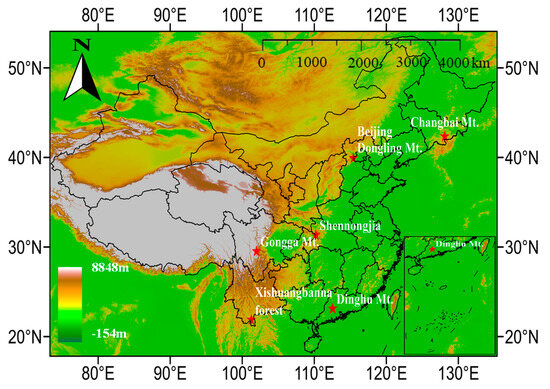
Figure 1.
Presents topographic map illustrating the geographic distribution of CARE-CHINA Network monitoring sites (red star) across China’s varied and complex landscapes.
2.2. MODIS Data
This study made use of aerosol optical depth (AOD) data obtained from MODIS instrument, specifically utilizing the collection 6.1 (C6.1) Level-2 operational aerosol retrieval datasets, which includes DT C6.1 algorithms for the period between 2004 and 2022. The data were obtained from the Level-1 and Atmospheric Archive & Distribution System (LAADS) Distributed Active Archive Center (DAAC), a NASA-managed archive for satellite-derived atmospheric and land surface information. The updated second-generation operational DT algorithm, as described by [42], has been employed to generate the latest DT dataset. The 3 km DT AOD product is derived from spectral reflectance, utilizing a look-up table and inversion similar to the methodology used for 10 km product [43]. By leveraging the linear relationship between spectral reflectance at the 0.47, 0.66, and 2.12 µm bands, MODIS DT effectively estimate the aerosol optical depth over most vegetated and dark surfaces [44]. The correction of the C6.1 product over land involved specific adjustments based on land and water proportions. When the coastal area in a 10 km x 10 km grid exceeded 50% or the water area surpassed 20%, the quality assurance (QA) for aerosol optical depth was set to zero. Additionally, if the urban area exceeded 20%, the calculation method for surface reflectance was revised using MODIS land reflectance and land cover type products [45]. The proposed study used the dataset known as “Optical_Depth_Land_And_Ocean”, obtained from C6.1 MOD04_L2 and MYD04_L2. It includes AOD values that have been filtered to provide quantitively reliable retrievals over dark targets, with a Quality Assurance (QA) level of 3 for AOD over land, signifying a high standard of data quality.
2.3. Validation Method
The proposed study validated MODIS DT retrievals (MOD04_3K and MYD04_3K) against ground-based AOD measurements from CARE-CHINA Network sites. Before conducting a comparative analysis, MODIS retrievals were typically averaged over a 50 × 50 km2 [46,47,48]. In order to evaluate how window size affects AOD, three different window sizes (10 × 10 km2, 30 × 30 km2, and 50 × 50 km2) were analyzed across all sites (Figure S1). While smaller windows (10 × 10 km2 and 30 × 30 km2) exhibit higher correlation, they suffer from limited sample sizes and reduced retrieval accuracy, resulting in unreliable statistics. Consequently, the 50 × 50 km2 was selected, as it provides sufficient quantity of valid pixels, large sample sizes, and more retrieval accuracy within the expected error. Temporal synchronization was established by selecting a ground-base measurement recorded within ±30 min window of the satellite overpass time, thereby ensuring appropriate spatiotemporal alignment for valid data comparison. The Microtop II Sunphotometer lacks direct measurement at 550 nm; therefore, AOD values at this wavelength were interpolated using available ground observation at 500 nm. This calculation employed the Angstrom exponent (α) for the wavelength (λ) of 440–675 nm spectral range. Following the established protocol in the literature [32,49] as defined in Equation (1).
For the quantitative assessment of MODIS AOD accuracy against the ground-based reference measurements, several statistical parameters were employed. The evaluation metrics include the Pearson correlation coefficient (R), root mean square error (RMSE) for AOD retrievals, relative mean bias (RMB) for over/underestimation, mean absolute error (MAE), the expected error (EE), percentage within expected error (=EE), percentage below expected error (<EE), and percentage above expected error (>EE). The statistical indicators are mathematically defined as follows:
EE = ±(0.05 + 0.20AODground)
3. Results
The validation and variations in accuracy for aerosol retrieval of updated MODIS Dark Target (DT), C6.1 MOD04 (Terra), and MYD04 (Aqua) at 3 km in comparison to ground-based AOD measurements are discussed. Figure 1 illustrated forested sites in China, including Beijing Dongling Mt. (BJF), Changbai forest site (CBF), Shennongjia site (SNJ), Gongga mountain (GGM), Dinghushan Mt. (DHM), and Xishuangbanna forest (BNF) from 2004 to 2022 with the exception of SNJ (2014–2017) and GGM (2012–2022).
3.1. Overall Performance of MODIS C6.1 DT Across Forest Background Areas of China
To evaluate performance, a thorough comparative analysis was undertaken involving total of 11,948 collocated MODIS aerosol retrievals of high quality, which included 6005 for Terra and 5943 for Aqua data. These retrievals were evaluated against ground-based measurements of aerosol optical depth (AOD) in forest background settings. Figure 2a,b displays the results of overall comparison between the MODIS DT with CARE-CHINA Network sites in China. The two products, Terra and Aqua, demonstrate similar performance regarding their AOD values and alignment with ground-based observations. Both products exhibit a correlation coefficient (R) of 0.75, indicating a good relationship between the MODIS AOD data and ground-based Sunphotometer measurements. The validation of MODIS AOD product is partly determined on the proportion of retrievals that fall within the expected error. According to [43,47], a MODIS AOD product is classified as having ‘good’ performance if more than 66% of the retrievals are contained within the expected error envelope. The total retrieval percentages fall within expected error envelope for Terra is 53.57% and for Aqua is 52.20%. In this context, both products in the forest background areas of China demonstrated poor performance, as they fall way short of achieving the 66% fraction target. The underperformance may be due to the complex interplay between and surface elevation and the dependence of reflectance on the geometrical configuration [34] of acquisition including solar zenith, viewing zenith, and relative azimuth, especially for the landscape characteristics and the coarse spatial resolution selected in this study. The assessment of AOD products Terra and Aqua for forest background areas in China revealed a significant underestimation of aerosol loadings. A substantial portion of data fell below the lower limit of error bounds, i.e., 30.06% for Terra and 34.61% for Aqua AODs. Additionally, the RMB for both products were less than the one specifically in Aqua. Because of variations in the retrieval process, the two AOD products exhibited varying performance across several aspects, such as the degree of underestimation when compared to the CARE-CHINA Network stations. Overall, the Terra product showed a better performance for forest background areas in China than the Aqua product. The assessment is derived from thorough analysis of all corresponding matches between the two products, which show a relatively high percentage of retrieval falling within the expected error 53.57% compared to 52.20%, lower uncertainty and bias, and RMB of 0.94 compared to 0.86. Furthermore, there are more matchups, with 6005 compared to the 5943 of the Aqua products. However, Aqua has a lower RMSE of 0.18 compared to 0.20. To investigate the underestimation of performance more thoroughly in relation to varying aerosol loadings, the bias at an interval of 0.1 from the Sunphotometer AOD was then analyzed. Figure 2c,d, both Terra and Aqua, shows a similar negative bias trend. The Aqua AOD data tends to underestimate aerosol optical depth more consistently than the Terra data particularly at higher AOD loadings.
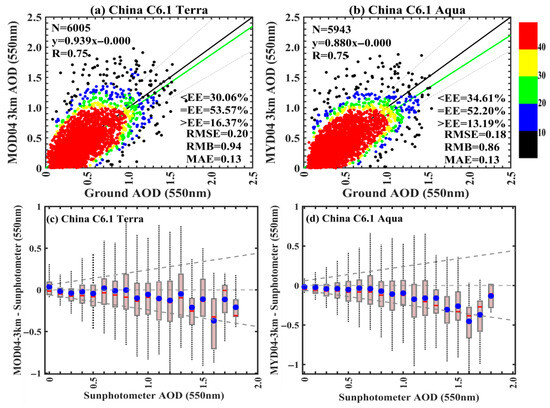
Figure 2.
(a,b) Frequency scattered plot of MODIS Terra and Aqua AOD with ground-based observations for China’s forested regions. The color dot represents the sample number in a rectangle of 0.2 × 0.2 centered by the dot. The black solid line, green solid line, and black. Dotted lines delineate the one-one-line, linear regression, and expected error envelope. (c,d) Box plots represent the bias (Satellite-Sunphotometer) values versus Sunphotometer (550 nm), the uppers and lowers of box plot marked by the first and third quartiles with the median representing by the central red line. The mean values are shown by a circle marker (blue) and the whisker extending vertically from the box shows the data distribution set at 1.5 times the inter quartile range. The straight-line y = 0 (zero line) and upper and lower lines are expected error displayed with gray coarse dashed lines.
To further investigate, the proposed study compared DT products with ground-observed data in each bin. Figure 3 shows the scattered plot of MODIS DT retrievals against ground measurements in the 0–2 bins. A comparative analysis of satellite-derived data and ground-based measurements reveals that systematic uncertainties in aerosol model assumption predominantly influence the slope of the linear regression. Moreover, the constant offset is primarily attributed to inaccuracies in surface reflectance estimation, reflecting errors in quantifying light reflected in the earth surface [47,49]. For both Terra and Aqua, the intercepts are near zero, which means a very low AOD, and both algorithms are unbiased; however, the Terra slope aligns better compared to Aqua. As depicted in Figure 3, the percentage within EE declines as AOD increases (0.2–0.6) in both Terra and Aqua except for a slight recovery at 0.8–1.0. It is important to highlight that both Terra and Aqua encounter severe failure at AOD > 1. Additionally, the percentage below EE values systemically increased in both Terra and Aqua from lower to higher AOD with the exception of the 0.4–0.8 range, where a slight decreased was observed in both products and then an increase again, worsening with AOD > 1 (38.54%) in Terra and (40.6%) in Aqua; however, the percentage above EE values decreased and increased, respectively, in both products, peaking at a 0.6–0.8 AOD range with above EE = 21% in Terra and between 0.4 and 0.6 AOD range in Aqua, with 16.9%, respectively. Bin-wise analysis reveals that MODIS Terra performed better than Aqua in extreme events (0–0.2 and >1), while Aqua exhibited superior performance in moderate AOD bins (0.2–0.4 and 0.6–0.8). The performance of both products is comparable in the 0.4–0.6 and 0.8–1.0 ranges.
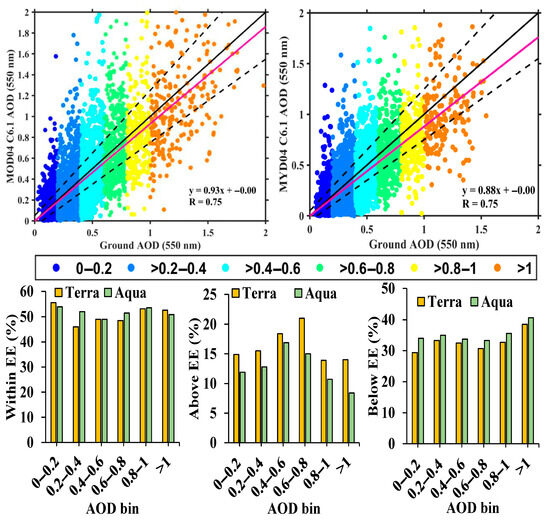
Figure 3.
Scattered plot of MODIS Terra (left) and Aqua (right) retrievals against ground measurements in the 0–2 bins. The black and pink solid line, and black dotted lines delineate the one-one-line, linear regression fit and expected error envelope. The colored marker represents AOD bin values. The bar graphs represent the percentage within EE, above EE, and below EE in each AOD bin.
3.2. Validation of MODIS C6.1 Terra and Aqua with Ground Observation at Six Different Forest Sites
Figure 4 and Table 2 and Table 3 illustrate a comparative analysis of MODIS 6.1 Terra and Aqua AOD in relation to ground-based observations across six sites. In the northern sites, both Terra and Aqua exhibited considerable underestimation of ground data. At BJF, Terra and Aqua showed moderate correlations of 0.67 and 0.62, respectively, with RMSE values of 0.15 and 0.16 indicating that Terra provide slightly more accurate AOD estimates. Terra also performed better in terms of correlation, higher matchups, and a smaller RMSE, reinforcing its reliability in this region. Similarly, at CBF, both products showed weak correlation (0.58) and lower RMSE of 0.12, further highlighting Terra’s comparative advantage. In the northern site, Terra consistently outperformed Aqua, not only in retrieval accuracy but also in number of matchups and retrieval falling within the EE envelope. This trend implies that Terra’s timing for observations or the calibration sensors is more advantageous for aerosol retrieval in the northern site than Aqua.
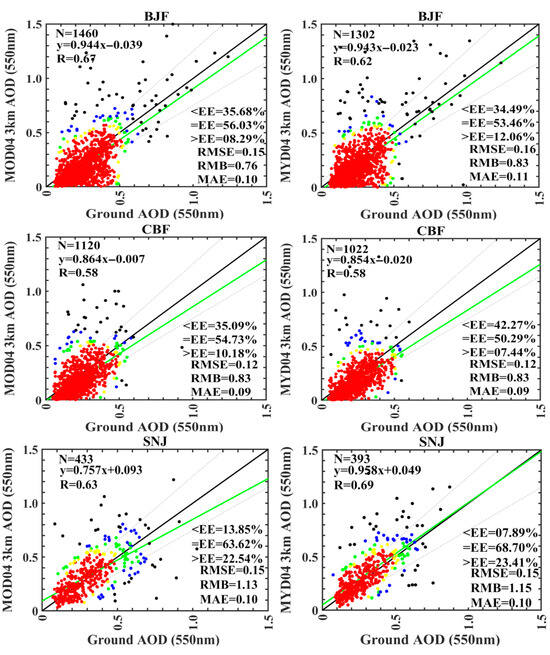
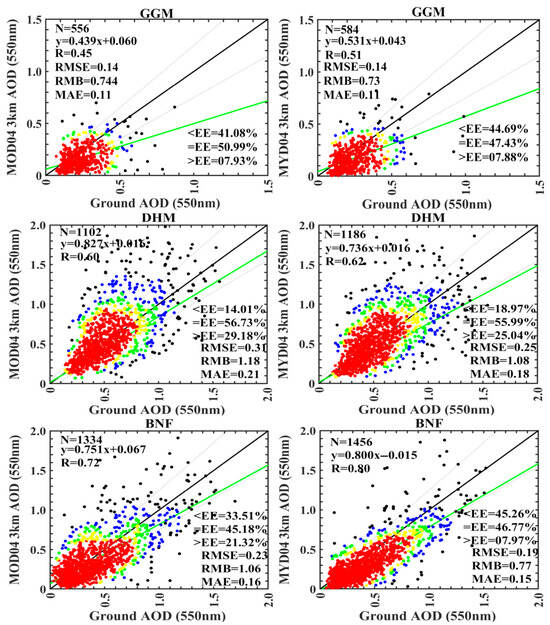
Figure 4.
Presents the frequency scattered plots validating MODIS 6.1 Terra (left) and Aqua (right) with ground-based AOD observations at BJF, CBF, SNJ, GGM, DHM, and BNF. The color dot represents the sample number in a rectangle of 0.2 × 0.2 centered by the dot. The black solid line, green solid line, and black dotted lines delineate the one-one-line, Linear Regression line, and expected error envelope.

Table 2.
Statistical overview for the validation of Terra (MOD04) AOD product. Ground and Terra AOD mean (and standard deviations) are derived from temporally matched pairs.

Table 3.
Statistical overview for the validation of Aqua (MYD04) AOD product. Ground and Aqua AOD Mean (and standard derivation) are derived from temporally matched pairs.
At the central site (SNJ), MODIS DT Terra and Aqua AOD retrieval aligned well with ground data, demonstrating moderate correlations (0.63, 0.69) and RMSE of 0.15 for both products. The EE values (Figure 4) indicated acceptable performance, though both satellite datasets exhibited a tendency towards overestimation compared to ground observations. Similar findings have been reported in an urban area (Wuhan) of central China [50]. This means that in central China, MODIS DT retrievals from both Terra and Aqua satellite perform well. Aqua outperformed Terra in correlation strength and EE compliance, meeting the 66% benchmark for acceptable retrievals, while Terra maintained an advantage in the number of successful matchups. These results confirm that both MODIS products perform reasonably well in central China, albeit with systematic overestimation bias. However, improved correlation and better EE compliance of Aqua indicate that it could be a more appropriate option for AOD monitoring in the central area, likely because its afternoon overpass time more effectively capture local aerosol conditions.
In southern sites (GGM, DHM, BNF), the accuracy of MODIS Terra and Aqua varied significantly. At GGM, both products exhibited the lowest correlations (R = 0.45 and 0.51), RMSE of 0.14, and EE values (Figure 4) indicating severe underestimation in both products. The poor performance at GGM can be attributed to the heterogeneity of aerosols induced by terrain and limitation associated with elevation in satellite retrieval algorithms. In contrast, the DHM site, situated in severely polluted PRD region of China displayed moderate correlation (0.60 for Terra, 0.62 for Aqua) but higher RMSE values (0.31 and 0.25, respectively). The retrieval within EE values (56.73% for Terra and 55.99% for Aqua) further suggest that both satellite products struggle to accurate capture AOD variability causing underestimation and overestimation. Conversely, BNF exhibited strong correlations for both Terra and Aqua (R = 0.72 and 0.80) and moderate RMSE (0.23 and 0.29). However, the percentage of retrieval within EE (45.18%, 46.77%) is notably low, suggesting persistence biases in both products. Aqua has slightly better EE compliance than Terra but suffered severe underestimation, while Terra showed mixed over and underestimation patterns.
The comprehensive evaluation demonstrates notable regional performance variation in MODIS Terra and Aqua AOD retrievals in China. Terra exhibits enhanced reliability in norther regions, while Aqua is better suited for central areas. In southern locations, performance exhibits considerable variability, especially showing subpar performance observed in high elevation areas.
3.3. Seasonal Comparison of MODIS C6.1 DT with Ground Observation
Previous studies have identified significant seasonal patterns in the performance of MODIS products [51], motivating us to explore the seasonality associated with Terra and Aqua MODIS AOD. Figure 5 summarizes the seasonal comparison of MODIS Terra and Aqua and ground-based observations at each site show a distinct seasonal variability. At the BJF site, significant underestimation is observed in the winter and spring seasons in Terra and autumn and winter in Aqua. However, both perform well in the summer season. While at the CBF site, notable underestimation can be seen in autumn and spring, with more severe observation in the Aqua product. In winter and summer, both Terra and aqua perform well, as the majority of matchups fall within EE. At the SNJ site, MODIS DT (Terra and Aqua) is in good agreement with ground data, performing well in all seasons (Figure 5) with matchups falling within EE except for the winter season, where Terra shows a slight overestimation.
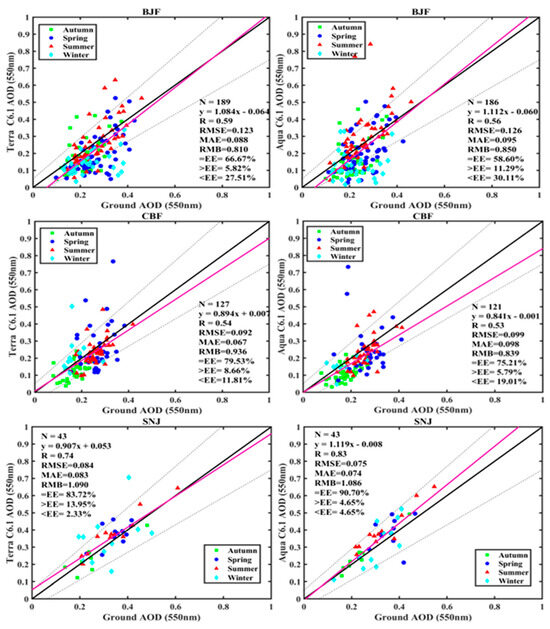
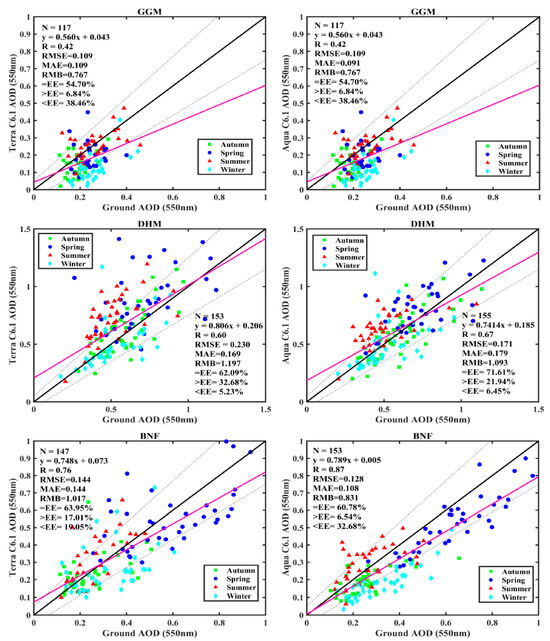
Figure 5.
Seasonal comparison of Terra (left) and Aqua (right) AOD retrievals against ground-based Sunphotometer measurements (550 nm) at six background forest locations. Each color point represents the seasonal mean AOD for winter (DJF), spring (MAM), summer (JJA), and autumn (SON). The black solid line, magenta solid line, and black dotted lines delineate the one-one-line, linear regression fit and expected error envelope.
In southern sites at GGM, Terra aligns well in the autumn and summer seasons, and Aqua in the summer season has a majority of matchup samples within EE. Nonetheless, in other seasons the GGM site shows dissimilarities; for example, almost all the winter matchups fall below EE with notable contributions from spring and summer, which lead to significant underestimation. Whereas at the DHM site, during the summer and the spring seasons, a notable number of matchups fall above EE, leading to an overestimation in Terra product. This is because the DHM site near to the city of Zhaoqing, close to the Pearl River Delta (PRD) region, where urbanized areas with brighter surfaces pose challenges for DT algorithm. In contrast, for Aqua matchups, the data falling within EE increased by 9.5%; still a notable proportion of data above EE is primarily associated with the summer and spring seasons. In BNF site Terra and Aqua perform well during summer and autumn; however, in spring and winter, they fail to capture the data accurately, resulting in a significant number of matchups falling below EE, which leads to underestimation. The underestimation is more severe in Aqua. During the dry season, biomass burning, transported pollution, and haze can affect surface reflectance and aerosol properties. This condition may lead to misclassification by the DT algorithm, which assumes dark surfaces and uniform aerosol characteristics.
3.4. Monthly Variation in MODIS and Sunphotometer AOD Observations
The monthly aerosol optical depth analysis presented in Figure 6, derived from MODIS C6.1 DT (MOD04 and MYD04) and Sun photometer data, was examined across six sites during the study period. At the BJF site, significant underestimation occurred from January to April and then again from October to December in both Terra and Aqua; nevertheless, Aqua slightly overestimated during July and August. At the CBF site, an overestimation occurred from January to March, peaking in February; however, in April, May, September, and October, significant underestimation was observed in Terra. Contrarily, Aqua showed consistent underestimation across the months, particularly during April, May, October, and November. At the SNJ site, Terra generally aligns well with the Sunphotometer; though, there was slight overestimation in February and August. Conversely, December showed notable underestimation, while Aqua followed the same pattern with notable deviation from June to August. At GGM, Terra significantly underestimated data from January to April and from October to December, but aligned more closely with ground data in May and September. Aqua displayed similar trends from January to April but aligned more closely with ground data in May, July, and September, albeit with slight overestimation in August. Notably, Aqua performance degraded severely in November and December with pronounced underestimation likely due to snow cover affecting surface reflectance assumptions. Both Terra and Aqua at the GGM site showed a similar trend, with significant underestimation from January to April and from October to December. At DHM, from May to September, Terra significantly overestimated the Sunphotometer data, whereas in January, October, November, and December it underestimated the Sunphotometer measurements. In contrast, Aqua exhibited a slight overestimation. At the BNF site, MODIS Terra agreed well with the Sun photometer from May to November, with a slight overestimation observed during the months of July and August, whereas from November to April, MODIS DT measurements demonstrated a tendency to underestimate the values recorded by the Sunphotometer. On the contrary, Aqua displayed satisfactory performance from April to August; however, it experienced considerable underestimation from October to April. The analysis of the six sites reveals temporal variation across different months. A consistent systematic underestimation is observed in all months at GGM and BJF sites by Terra and as well as at GGM and CBF sites by Aqua. Conversely, the DHM site demonstrates a significant overestimation during the spring and summer months. At the BNF site, both Terra and Aqua exhibit a tendency to underestimate Sunphotometer data during the winter and spring seasons. At the SNJ site, MODIS C6.1 DT AOD demonstrated close alignment with Sunphotometer data for most months, with June and August showing notable exceptions.
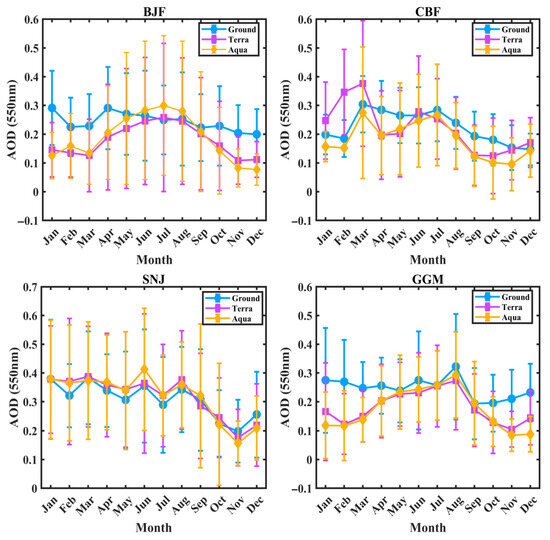
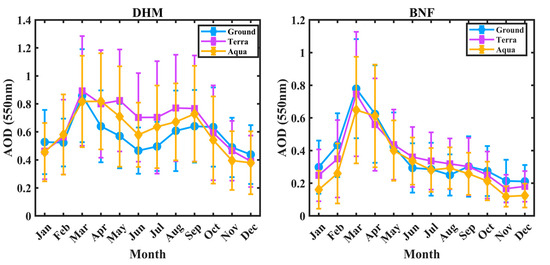
Figure 6.
Monthly mean variations in MODIS DT (MOD04 and MYD04) 3 km AOD with ground-based Sun photometer measurements (AOD at 550 nm) over six forest background areas of China.
3.5. MODIS C6.1 DT and Sunphotometer AOD Bias Across Ground AOD Bin and Angstrom Exponent Ranges
3.5.1. AOD Bias Variability Across Sunphotometer AOD
Figure 7 displays the box plots of AOD differences between ground-based Sunphotometer observations and MODIS Terra and Aqua retrievals for all six sites. At the BJF site, MODIS DT (Terra and Aqua) with ground observations agree well for AOD values <0.1 and >0.5; however, a more pronounced negative bias is observed for AOD values between 0.3 and 0.5. Conversely, at the CBF site, both products show a minimal bias for AOD values <0.2; however, the negative bias become more significant for values >0.3, which indicates substantial underestimation, intensifying with increasing AOD values. At the SNJ site, agreement is strong for AOD values between 0.1 and 0.5 for Terra; however, notable negative bias is noted for values >0.5 and a positive offset at <0.1 values. Similarly, there are low biases in Aqua with ground observations, with a small positive offset at AOD values between 0.3 and 0.5. At the GGM site, systematic negative biases are observed as AOD values increase. These biases become more pronounced for values greater than 0.5. Both Terra and Aqua fail to effectively capture high AOD values, with retrievals falling below the expected error bounds, contributing to significant underestimation at this site. The DHM site exhibits notable positive biases within the 0.1–0.5 range, while negative bias appears at values greater than 0.5. These biases in Terra and Aqua lead to both overestimation and underestimation; however, Aqua shows a more pronounced negative bias at AOD values >0.5. At the BNF site, for AOD values below 0.1, both Terra and Aqua exhibit positive offsets. However, as AOD values increase, the negative bias intensifies, reaching its peak at values above 0.5, with Aqua showing a more pronounced underestimation.
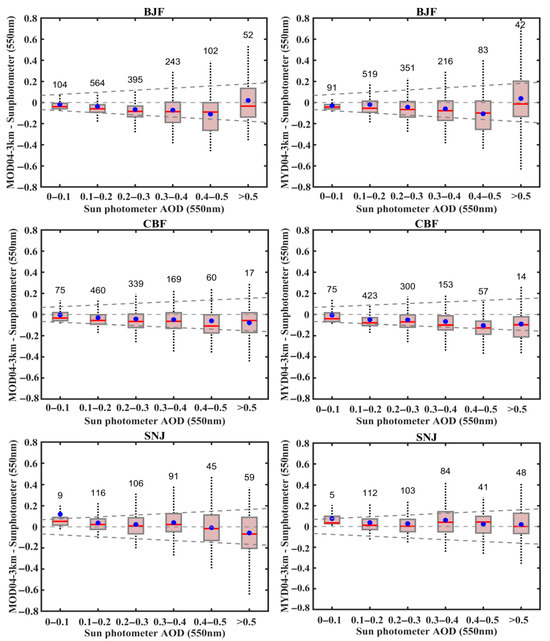
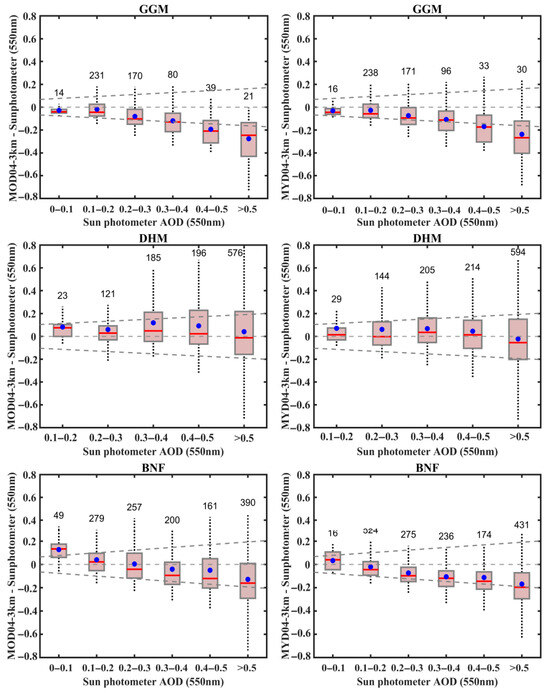
Figure 7.
Box plots represent the bias (Satellite-Sunphotometer) values versus Sunphotometer (550 nm) at six different background sites. The above x-axis title represents the site name, with each box number referring to statistical collocations, and the straight-line y = 0 (zero line) and upper and lower lines are expected errors, displayed as gray coarse dashes lines.
MODIS DT (Terra and Aqua) agrees well with ground observations in the lower range at the northern site; however, discrepancies increase between satellite and ground observations as AOD values increase. At the central site, both products agree well, with some instances of overestimation in the lower range. However, Terra shows a negative trend at high AOD, while Aqua, on the other hand, shows a pronounced positive offset in the mid-range. At the southern site, GGM stands out by showing significant differences compared to other locations. DHM is unique in displaying positive bias over a broader range of AOD bins, whereas the BNF site shows systematic negative biases across all bins in both Terra and Aqua, except for the very low range. This finding contradicts a previous study, which posited that MODIS DT tended to overestimate AOD in mainland China [36].
The difference arises due to variation in the study area, land cover type, and aerosol characteristics. Huang et al. (2019) [36] suggested that the C6.1 DT biases against ground observation in mainland China are positive, leading to overestimation. This is attributed to the underestimation of surface reflectance and inappropriate aerosol scheme [35]. On the contrary, our study found that at most sites, the biases are negative, indicating that MODIS DT underestimated ground observations in forest areas. This may be due to overestimated surface reflectance and unresolved Bidirectional Reflectance Distribution Function (BRDF) effects. Furthermore, the analysis conducted by [36] indicated that in mainland China, a decrease in AOD corresponds with an increased in overestimation. This was attributed to the fact that the same uncertainty had a more pronounced effect on low retrievals than on high retrievals. Conversely, our results indicated that in most cases, an increase in AOD was linked to an increase in underestimation. In addition, at the very low AOD range (0–0.1) some sites show positive biases. When aerosol loading is low, the satellite signal approaches the noise floor of the sensor and retrieval algorithm, making it challenging to separate the aerosol signal from the variability in surface reflectance. This results in positive biases particularly for Terra, which [52] found to exhibit a slightly higher mean positive biased (0.06) than aqua (0.03).
3.5.2. AOD Bias Variability Across Angström Exponent Ranges
Inconsistencies in measurements of aerosol optical thickness over land are associated with changes in the distribution of aerosol particle sizes [53,54]. Therefore, we further investigate the differences between Angstrom exponent ranges. Figure 8 shows the box plot of AOD differences between MODIS Terra and Aqua with ground observations retrieval against Angstrom exponent (AE) measurements by Sunphotometer at the range of 440–675 nm. Both MODIS DT (Terra and Aqua) at BJF and CBF show fewer biases at higher AE values; however, noticeable biases occur at both sites when AE < 1. The SNJ site shows minimal biases across all AE ranges. Both Terra and Aqua show strong agreement when AE is <1; however, at higher AE values both show a slight positive bias with more evident in Aqua. At the GGM site, both Terra and Aqua show more negative biases when AE < 1 specially in Aqua where AE values fall below the expected error envelope at <0.5 range. At the DHM site, MODIS Terra shows good agreement with all AE ranges; however, a small positive bias can be seen in lower AE range (<0.5), while in Aqua negative biases at AE < 0.5 and a slight positive bias when AE is >1.5. In contrast, at the BNF site, low biases occur when AE < 1 and increase with AE increases, being more pronounced in Aqua at a high AE range; however, Terra shows a small positive offset when AE is <0.5. From the above analysis we can conclude that MODIS C6.1 DT (Terra and Aqua) is not performed well when the aerosols are dominated by coarse mode and vice versa in all forest background sites with the exception of BNF; here, biases increase with the increase in fine particulate.
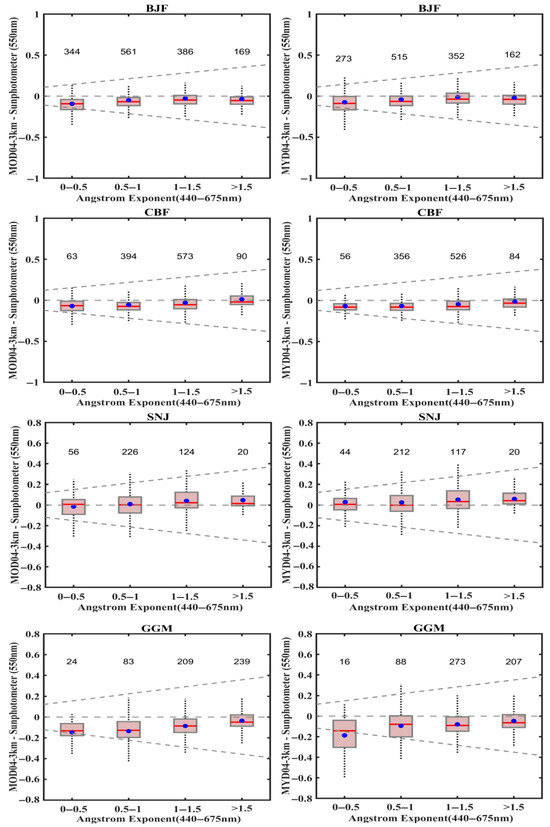
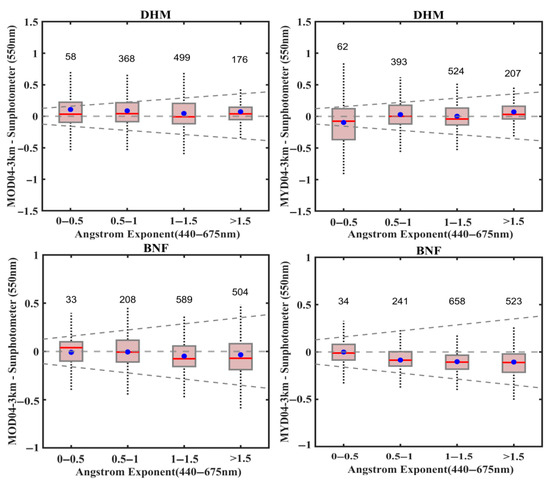
Figure 8.
Box plots represent the bias (Satellite-Sunphotometer) values versus Angstrom ex-ponent (440–675 nm) at six different background sites. The above x-axis title represents the site name, the straight-line y = 0 (zero line) and upper and lower lines are expected error display in gray coarse dashes lines.
4. Discussion
It is imperative to substantiate remote sensing capabilities for monitoring aerosol distribution, particularly in ecologically sensitives and remote forested areas, which are lacking in the existing literature. The MOD04_3K Terra and MYD04_3K Aqua-updated MODIS Collection 6.1 was selected due to its high-quality algorithm design, sensor characteristics, and validation results, thereby reflecting the overall efficacy of the MODIS system. The proposed study has compared the two products (MOD04_3K and MYD04_3K) retrieval accuracy with six different Chinese forested regions. The study revealed that MODIS C6.1 DT products underestimate AOD in China’s forested regions, with only 53.57% (Terra) and 52.20% (Aqua) of retrieval within EE. Regional differences were evident in the performance of both products. Terra performed better at the northern site, while Aqua outperformed Terra at the central site. The southern site displayed a heterogeneous retrieval pattern, with more discrepancies noted in Aqua. Both products underperform in complex terrain and under high AOD conditions. Seasonal biases were more pronounced in winter and spring, with stronger negative biases linked with coarse particle sizes observed across all sites except Xishuangbanna, where fine mode aerosols dominate.
Before the interpretation of our results, it is essential to address several limitations. First, the study uses data from six CARE-CHINA locations, which do not encompass China’s varied landscapes. Although these sites represent a diverse forest ecosystem, they were chosen for their ecological relevance and their alignments with MODIS overpass timings. In the future, the validation scope should be expanded in conjunction with the AERONET. Second, the study excluded the analysis of underlying surface properties such as surface reflectance, landcover, and elevation, since these analyses were not part of its focus. Subsequent studies should consider these aspects to deepen understanding. Third, the 50 km window masks sub-grid terrain-driven BRDF effects, especially at high-elevation sites (GGM), where unresolved shadows and slopes alter reflectance estimates. Subsequent studies should include terrain-adjusted BRDF models and topographic correction methods. Notwithstanding the limitations, this study offers an in-depth analysis to evaluate the accuracy of MODIS DT data in China’s understudied forested regions. The research fills a significant gap in the aerosol validation literature by combining long-term satellite data with high quality ground observation from CARE-CHINA Network provide fresh insights into the biases present in satellite retrieval and discrepancies between sensors (Terra and Aqua) in forested areas.
The performance of MODIS Terra (MOD04) and Aqua (MYD04) algorithms in the forested areas of China is less accurate than global accuracy (66% within EE). A similar finding was observed by [55,56] where DT 3 km was also unsatisfactory with lowest percentage within EE for forested site. Importantly, despite forest sites being ideal for DT due to their dark vegetative cover, the retrieval accuracy was unexpectedly low. This can be attributed to three main factors.
Surface reflectance: At the northern site (BJF and CBF), both Terra and Aqua exhibited significant underestimation. This contrasts with urban areas like Beijing, where prior studies [35,36,37] reported a significant overestimation as a result of underestimation of surface reflectance and inappropriate aerosol type. These discrepancies highlight DT’s reliance on dark surface assumptions, which fail in heterogeneous rural–urban transitions. Conversely, at Dinghu Mt. (DHM), both Terra and Aqua show a tendency to overestimate. However, the findings are inconsistent with those at the rural site in the PRD region (HK_Shueng) [36]. This is because HK_Shueng has a limited number of matchup samples (n = 27), which likely represent optimal retrieval conditions and skew the result favorably. At DHM, overestimation mainly occurs in spring and summer, the peak growing seasons in the PRD hinterlands. Bare soil resulting from plowing can elevate surface reflectance, contradicting the dark assumption of DT. At Xishuangbanna (BNF), a significant underestimation was observed in both products, especially in Aqua, while Terra also exhibited a considerable tendency to overestimate AOD. Both products performed poorly during the winter and spring seasons, where biomass burning often occurred, altering surface reflectance properties. Furthermore, seasonal correlation (R = 0.42–0.87) variations indicate that the surface type is not the only factor influencing retrieval performance. Instead, the spatial diversity in land cover, along with the seasonal dynamics of the land surface has a significant impact on retrieval success.
Aerosol model limitations: The performance of AOD retrieval was significantly influenced by the aerosol type and particle size, especially under coarse or fine-mode dominance. At the northern site, winter underestimation was likely due to reduced vegetation and snow cover, while in the spring, the dust effect may be the reason. Tian et al. (2019) reported that in dust dominated cases, bias becomes more negative with the increase in AOD, and Wei et al. (2019) found that areas where continental and dust aerosol dominate DT algorithm performance deteriorates in such conditions, which may explain the northern site results [31,51]. Contrary to other sites where DT retrieval generally performs better at AE > 1.5, sites influenced by biomass burning and transportation pollution deviate from this pattern due to unique optical properties of smoke aerosol, surface brightening, and aerosol layering. The clear variation in bias across AE categories indicates that most sites showed higher error in coarse-mode conditions, but BNF exhibited increased error when fine-mode condition prevailed. These findings confirm that DT performance is significantly influenced by the local aerosol composition and their optical characteristics.
Complex Terrain: At Gongga Mt. (GGM), both Terra and Aqua exhibited the lowest accuracy among all sites, with significant underestimation. The station is located near the eastern edge of the Tibetan Plateau, with an altitude of 2950 m, which suggests that mountainous terrain may pose challenges for MODIS retrieval accuracy due to cloud cover and elevation variations. You et al. (2020) similarly reported reduced DT accuracy in the eastern Tibetan plateau, linked to low AOD, complex terrain, and bare land cover [38]. Furthermore, this discrepancy is exacerbated by unresolved terrain-driven errors, particularly at high-elevation sites like Gongga Mt., where steep slopes and complex topography distort surface reflectance estimates under varying solar-viewing geometries [34].
These findings highlight several important avenues for future research. MODIS DT products should be evaluated in relation to surface reflectance, land cover, and elevation at each site to evaluate its efficacy for aerosol retrieval. The development of region-specific aerosol models, tailored to both fine-mode and coarse-mode categories, is imperative for minimizing biases in high aerosol loading conditions as well as seasonal biases. Furthermore, advanced algorithms like MAIAC, which integrates time series analysis and BRDF-based surface reflectance modeling, offer promising improvements for aerosol retrieval in forested/grassland. Incorporating MAIAC into retrieval strategies can help overcome the limitations of MODIS DT over forested regions.
5. Conclusions
This study revealed that MODIS AOD products consistently underestimated AOD in northern sites. The central site showed better agreement, particularly with Aqua dataset, while southern sites displayed heterogeneous AOD retrieval patterns, including both systematic under- and overestimations. Seasonal variations significantly affected retrieval accuracy; spring and winter generally resulted in underestimation across most sites, except at the Dinghu Mt. site, where summer led to overestimations. Bias increased with high AOD values, especially in the southern sites. Aerosol particle size significantly influenced bias pattern: northern sites exhibited more pronounced negative biases with coarse mode particles, while the central site showed slight positive biases for fine mode particles. The southern sites displayed a heterogeneous pattern of negative biases across different particle sizes, which was more pronounced at Gongga Mt. To our knowledge, this is the most comprehensive study to validate the MODIS C6.1 DT collection accuracy in the complex forested regions of China. The proposed research addresses the sparse validation of MODIS aerosol products in complex forested landscapes, providing a crucial reference for enhancing retrieval algorithms and supporting regional air quality and climate modeling efforts.
Supplementary Materials
The following supporting information can be downloaded at: https://www.mdpi.com/article/10.3390/rs17142401/s1, Figure S1: Scatter plots and relationship between different ground observed AOD and MODIS AOD over different window sizes (10 × 10 km2, 30 × 30 km2, and 50 × 50 km2), the color of a dot represents the number of dots in a rectangle of 0.2 × 0.2 centered by the sample point, p represents the percentage of retrieval within expected error.
Author Contributions
Conceptualization, J.X. and M.A.; methodology, L.K. and M.A.; software, M.A. and Y.M.; validation, J.X., Y.M. and Y.T.; formal analysis, M.A. and L.K.; investigation, M.A. and J.X.; resources, J.X. and Y.M.; data curation, J.X.; writing—original draft preparation, M.A.; writing—review and editing, J.X., Y.M. and M.A.; visualization, M.A. and Y.T.; supervision, J.X. and L.K.; project administration, J.X.; funding acquisition, J.X. All authors have read and agreed to the published version of the manuscript.
Funding
This study was supported by the National Key R&D Program of China (No. 2022YFF0802501), the CAS Strategic Priority Research Program (XDB0760100), the National Natural Science Foundation of China (42475180, 42305090).
Data Availability Statement
The data underlying this article will be shared on reasonable request to the corresponding author.
Conflicts of Interest
The authors declare no conflicts of interest.
References
- Che, H.; Qi, B.; Zhao, H.; Xia, X.; Eck, T.F.; Goloub, P.; Dubovik, O.; Estelles, V.; Cuevas-Agulló, E.; Blarel, L. Aerosol optical properties and direct radiative forcing based on measurements from the China Aerosol Remote Sensing Network (CARSNET) in eastern China. Atmos. Chem. Phys. 2018, 18, 405–425. [Google Scholar] [CrossRef]
- Intergovernmental Panel on Climate Change (IPCC). Climate Change 2021: The Physical Science Basis. In Contribution of Working Group I to the Sixth Assessment Report of the Intergovernmental Panel on Climate Change; Cambridge University Press: Cambridge, UK; New York, NY, USA, 2021. [Google Scholar]
- He, Q.S.; Li, C.; Mao, J.; Lau, A.K.H.; Li, P. A study on the aerosol extinction-to-backscatter ratio with combination of micro-pulse LIDAR and MODIS over Hong Kong. Atmos. Chem. Phys. 2006, 6, 3243–3256. [Google Scholar] [CrossRef]
- Logan, T.; Xi, B.; Dong, X.; Li, Z.; Cribb, M. Classification and investigation of Asian aerosol absorptive properties. Atmos. Chem. Phys. 2013, 13, 2253–2265. [Google Scholar] [CrossRef]
- Li, Z.; Zhao, X.; Kahn, R.; Mishchenko, M.; Remer, L.; Lee, K.-H.; Wang, M.; Laszlo, I.; Nakajima, T.; Maring, H. Uncertainties in satellite remote sensing of aerosols and impact on monitoring its long-term trend: A review and perspective. Ann. Geophys. 2009, 27, 2755–2775. [Google Scholar] [CrossRef]
- Povey, A.; Grainger, R. Known and unknown unknowns: Uncertainty estimation in satellite remote sensing. Atmos. Meas. Tech. 2015, 8, 4699–4718. [Google Scholar] [CrossRef]
- Sun, K.; Gao, Y.; Qi, B.; Yu, Z. The influence of underlying land cover on the accuracy of MODIS C6.1 aerosol products—A case study over the Yangtze River Delta region of China. Remote Sens. 2022, 14, 938. [Google Scholar] [CrossRef]
- Qin, W.; Fang, H.; Wang, L.; Wei, J.; Zhang, M.; Su, X.; Bilal, M.; Liang, X. MODIS high-resolution MAIAC aerosol product: Global validation and analysis. Atmos. Environ. 2021, 264, 118684. [Google Scholar] [CrossRef]
- Papachristopoulou, K.; Raptis, I.-P.; Gkikas, A.; Fountoulakis, I.; Masoom, A.; Kazadzis, S. Aerosol optical depth regime over megacities of the world. Atmos. Chem. Phys. 2022, 22, 15703–15727. [Google Scholar] [CrossRef]
- Gupta, G.; Ratnam, M.V.; Madhavan, B.; Narayanamurthy, C. Long-term trends in aerosol optical depth obtained across the globe using multi-satellite measurements. Atmos. Environ. 2022, 273, 118953. [Google Scholar] [CrossRef]
- Mei, L.; Xue, Y.; de Leeuw, G.; von Hoyningen-Huene, W.; Kokhanovsky, A.A.; Istomina, L.; Guang, J.; Burrows, J.P. Aerosol optical depth retrieval in the Arctic region using MODIS data over snow. Remote Sens. Environ. 2013, 128, 234–245. [Google Scholar] [CrossRef]
- Jung, C.H.; Lee, J.Y.; Um, J.; Lee, S.S.; Yoon, Y.J.; Kim, Y.P. Estimation of source-based aerosol optical properties for polydisperse aerosols from receptor models. Appl. Sci. 2019, 9, 1443. [Google Scholar] [CrossRef]
- Caido, N.G.; Ong, P.M.; Rempillo, O.; Galvez, M.C.; Vallar, E. Spatiotemporal analysis of MODIS aerosol optical depth data in the Philippines from 2010 to 2020. Atmosphere 2022, 13, 939. [Google Scholar] [CrossRef]
- Xia, X.; Che, H.; Shi, H.; Chen, H.; Zhang, X.; Wang, P.; Goloub, P.; Holben, B. Advances in sunphotometer-measured aerosol optical properties and related topics in China: Impetus and perspectives. Atmos. Res. 2021, 249, 105286. [Google Scholar] [CrossRef] [PubMed]
- Xie, Y.; Li, Z.; Li, L.; Wagener, R.; Abboud, I.; Li, K.; Li, D.; Zhang, Y.; Chen, X.; Xu, H. Aerosol optical, microphysical, chemical and radiative properties of high aerosol load cases over the Arctic based on AERONET measurements. Sci. Rep. 2018, 8, 9376. [Google Scholar] [CrossRef]
- Khatri, P.; Takamura, T.; Nakajima, T.; Estellés, V.; Irie, H.; Kuze, H.; Campanelli, M.; Sinyuk, A.; Lee, S.M.; Sohn, B. Factors for inconsistent aerosol single scattering albedo between SKYNET and AERONET. J. Geophys. Res. Atmos. 2016, 121, 1859–1877. [Google Scholar] [CrossRef]
- Xin, J.; Wang, Y.; Pan, Y.; Jin, D.; Liu, Z.; Wang, T.; Wang, Y.; Liu, X.; Sun, Y.; Sun, J.; et al. The campaign on atmospheric aerosol research network of China: CARE-China. Bull. Am. Meteorol. Soc. 2015, 96, 1137–1155. [Google Scholar] [CrossRef]
- Kaufman, Y.; Koren, I.; Remer, L.; Tanré, D.; Ginoux, P.; Fan, S. Dust transport and deposition observed from the Terra-Moderate Resolution Imaging Spectroradiometer (MODIS) spacecraft over the Atlantic Ocean. J. Geophys. Res. Atmos. 2005, 110, D10. [Google Scholar] [CrossRef]
- Dubovik, O.; Holben, B.; Eck, T.F.; Smirnov, A.; Kaufman, Y.J.; King, M.D.; Tanré, D.; Slutsker, I. Variability of Absorption and Optical Properties of Key Aerosol Types Observed in Worldwide Locations. J. Atmos. Sci. 2002, 59, 590–608. [Google Scholar] [CrossRef]
- Lipponen, A.; Mielonen, T.; Pitkänen, M.R.; Levy, R.C.; Sawyer, V.R.; Romakkaniemi, S.; Kolehmainen, V.; Arola, A. Bayesian aerosol retrieval algorithm for MODIS AOD retrieval over land. Atmos. Meas. Tech. 2018, 11, 1529–1547. [Google Scholar] [CrossRef]
- Mhawish, A.; Kumar, M.; Mishra, A.K.; Srivastava, P.K.; Banerjee, T. Remote Sensing of Aerosols from Space: Retrieval of Properties and Applications. In Remote Sensing of Aerosols, Clouds, and Precipitation; Elsevier: Amsterdam, The Netherlands, 2018; pp. 45–83. [Google Scholar]
- Lyapustin, A.; Wang, Y.; Laszlo, I.; Kahn, R.; Korkin, S.; Remer, L.; Levy, R.; Reid, J.S. Multiangle Implementation of Atmospheric Correction (MAIAC): 2. Aerosol Algorithm. J. Geophys. Res. 2011, 116, D03211. [Google Scholar] [CrossRef]
- Remer, L.A.; Kaufman, Y.J.; Tanré, D.; Mattoo, S.; Chu, D.A.; Martins, J.V.; Holben, B.N. The MODIS Aerosol Algorithm, Products, and Validation. J. Atmos. Sci. 2005, 62, 947–973. [Google Scholar] [CrossRef]
- Fan, R.; Ma, Y.; Jin, S.; Gong, W.; Liu, B.; Wang, W.; Li, H.; Zhang, Y. Validation, analysis, and comparison of MISR V23 aerosol optical depth products with MODIS and AERONET observations. Sci. Total Environ. 2023, 856, 159117. [Google Scholar] [CrossRef] [PubMed]
- Hsu, N.; Lee, J.; Sayer, A.; Kim, W.; Bettenhausen, C.; Tsay, S.C. VIIRS deep blue aerosol products over land: Extending the EOS long-term aerosol data records. J. Geophys. Res. Atmos. 2019, 124, 4026–4053. [Google Scholar] [CrossRef]
- Zhang, W.; Xu, H.; Zheng, F. Aerosol optical depth retrieval over East Asia using Himawari-8/AHI data. Remote Sens. 2018, 10, 137. [Google Scholar] [CrossRef]
- Nichol, J.E.; Bilal, M. Validation of MODIS 3 km resolution aerosol optical depth retrievals over Asia. Remote Sens. 2016, 8, 328. [Google Scholar] [CrossRef]
- Lyapustin, A.; Wang, Y.; Korkin, S.; Huang, D. MODIS Collection 6 MAIAC Algorithm. Atmospheric. Measurement. Techniques 2018, 11, 5741–5765. [Google Scholar] [CrossRef]
- Shao, Y.; Taff, G.N.; Lunetta, R.S. Review of Selected Moderate-Resolution Imaging Spectroradiometer Algorithms, Data Products, and Applications. In Advances in Environmental Remote Sensing, 1st ed.; Weng, Q., Ed.; CRC Press: Boca Raton, FL, USA, 2011; p. 265. [Google Scholar]
- Li, B.; Yuan, H.; Feng, N.; Tao, S. Comparing MODIS and AERONET aerosol optical depth over China. Intern. J. Remote Sens. 2009, 30, 6519–6529. [Google Scholar] [CrossRef]
- Wei, J.; Li, Z.; Peng, Y.; Sun, L. MODIS Collection 6.1 aerosol optical depth products over land and ocean: Validation and comparison. Atmos. Environ. 2019, 201, 428–440. [Google Scholar] [CrossRef]
- Zhang, M.; Zhang, L.; He, Q.; Yuan, Y. Evaluation of the MODIS Collection 6.1 3 km aerosol optical depth product over China. Atmos. Environ. 2022, 273, 118970. [Google Scholar] [CrossRef]
- Musonda, B.; Jing, Y.; Nyasulu, M.; Libanda, B. Long-term spatial and temporal variations of aerosol optical depth during 2000–2020 over Zambia, southcentral Africa. Air Qual. Atmos. Health 2022, 15, 177–193. [Google Scholar] [CrossRef]
- Mhawish, A.; Banerjee, T.; Sorek-Hamer, M.; Lyapustin, A.; Broday, D.M.; Chatfield, R. Comparison and Evaluation of MODIS Multi-angle Implementation of Atmospheric Correction (MAIAC) Aerosol Product over South Asia. Remote Sens. Environ. 2019, 224, 12–28. [Google Scholar] [CrossRef]
- Tian, X.; Liu, Q.; Li, X.; Wei, J. Validation and comparison of MODIS C6.1 and C6 aerosol products over Beijing, China. Remote Sens. 2018, 10, 2021. [Google Scholar] [CrossRef]
- Huang, Y.; Zhu, B.; Zhu, Z.; Zhang, T.; Gong, W.; Ji, Y.; Xia, X.; Wang, L.; Zhou, X.; Chen, D. Evaluation and comparison of MODIS Collection 6.1 and Collection 6 dark target aerosol optical depth over mainland China under various conditions including spatiotemporal distribution, haze effects, and underlying surface. Earth Space Sci. 2019, 6, 2575–2592. [Google Scholar] [CrossRef]
- Wang, Y.; Yuan, Q.; Li, T.; Shen, H.; Zheng, L.; Zhang, L. Evaluation and comparison of MODIS Collection 6.1 aerosol optical depth against AERONET over regions in China with multifarious underlying surfaces. Atmos. Environ. 2019, 200, 280–301. [Google Scholar] [CrossRef]
- You, Y.; Zhao, T.; Xie, Y.; Zheng, Y.; Zhu, J.; Xia, J.; Cao, L.; Wang, C.; Che, H.; Liao, Y. Variation of the aerosol optical properties and validation of MODIS AOD products over the eastern edge of the Tibetan Plateau based on ground-based remote sensing in 2017. Atmos. Environ. 2020, 223, 117257. [Google Scholar] [CrossRef]
- Ma, Y.; Li, Z.; Li, Z.; Xie, Y.; Fu, Q.; Li, D.; Zhang, Y.; Xu, H.; Li, K. Validation of MODIS aerosol optical depth retrieval over mountains in central China based on a sun-sky radiometer site of SONET. Remote Sens. 2016, 8, 111. [Google Scholar] [CrossRef]
- Liu, Z.; Gao, W.; Yu, Y.; Hu, B.; Xin, J.; Sun, Y.; Wang, L.; Wang, G.; Bi, X.; Zhang, G. Characteristics of PM2.5 mass concentrations and chemical species in urban and background areas of China: Emerging results from the CARE-China network. Atmos. Chem. Phys. 2018, 18, 8849–8871. [Google Scholar] [CrossRef]
- Xin, J.; Wang, Y.; Li, Z.; Wang, P.; Hao, W.M.; Nordgren, B.L.; Wang, S.; Liu, G.; Wang, L.; Wen, T. Aerosol optical depth (AOD) and Ångström exponent of aerosols observed by the Chinese Sun Hazemeter Network from August 2004 to September 2005. J. Geophys. Res. Atmos. 2007, 112, D5. [Google Scholar] [CrossRef]
- Levy, R.C.; Hsu, N.C. MODIS Atmosphere L2 Aerosol Product; NASA MODIS Adaptive Processing System; Goddard Space Flight Center: Greenbelt, MD, USA, 2015. [Google Scholar]
- Remer, L.A.; Mattoo, S.; Levy, R.C.; Munchak, L.A. MODIS 3 km aerosol product: Algorithm and global perspective. Atmos. Meas. Tech. 2013, 6, 1829–1844. [Google Scholar] [CrossRef]
- Levy, R.C.; Remer, L.A.; Mattoo, S.; Vermote, E.F.; Kaufman, Y.J. Second-generation operational algorithm: Retrieval of aerosol properties over land from inversion of Moderate Resolution Imaging Spectroradiometer spectral reflectance. J. Geophys. Res. Atmos. 2007, 112, D13. [Google Scholar] [CrossRef]
- Gupta, P.; Levy, R.C.; Mattoo, S.; Remer, L.A.; Munchak, L.A. A surface reflectance scheme for retrieving aerosol optical depth over urban surfaces in MODIS Dark Target retrieval algorithm. Atmos. Meas. Tech. 2016, 9, 3293–3308. [Google Scholar] [CrossRef]
- Ichoku, C.; Levy, R.; Kaufman, Y.J.; Remer, L.A.; Li, R.R.; Martins, V.J.; Holben, B.N.; Abuhassan, N.; Slutsker, I.; Eck, T.F. Analysis of the performance characteristics of the five-channel Microtops II Sun photometer for measuring aerosol optical thickness and precipitable water vapor. J. Geophys. Res. Atmos. 2002, 107, AAC 5–AAC 17. [Google Scholar] [CrossRef]
- Levy, R.; Remer, L.; Kleidman, R.; Mattoo, S.; Ichoku, C.; Kahn, R.; Eck, T. Global evaluation of the Collection 5 MODIS Dark-Target aerosol products over land. Atmos. Chem. Phys. 2010, 10, 10399–10420. [Google Scholar] [CrossRef]
- Wang, L.; Xin, J.; Wang, Y.; Li, Z.; Liu, G.; Li, J. Evaluation of the MODIS aerosol optical depth retrieval over different ecosystems in China during EAST-AIRE. Atmos. Environ. 2007, 41, 7138–7149. [Google Scholar] [CrossRef]
- Sayer, A.M.; Hsu, N.; Bettenhausen, C.; Jeong, M.J. Validation and uncertainty estimates for MODIS Collection 6 Deep Blue aerosol data. J. Geophys. Res. Atmos. 2013, 118, 7864–7872. [Google Scholar] [CrossRef]
- Wang, W.; Mao, F.; Pan, Z.; Du, L.; Gong, W. Validation of VIIRS AOD through a comparison with a sun photometer and MODIS AODs over Wuhan. Remote Sens. 2017, 9, 403. [Google Scholar] [CrossRef]
- Tian, X.; Gao, Z. Validation and accuracy assessment of MODIS C6.1 aerosol products over the heavy aerosol loading area. Atmosphere 2019, 10, 548. [Google Scholar] [CrossRef]
- Gupta, P.; Remer, L.A.; Levy, R.C.; Mattoo, S. Validation of MODIS 3 km Land Aerosol Optical Depth from NASA’s EOS Terra and Aqua Missions. Atmos. Meas. Tech. 2018, 11, 3145–3159. [Google Scholar] [CrossRef]
- Huang, G.; Chen, Y.; Li, Z.; Liu, Q.; Wang, Y.; He, Q.; Liu, T.; Liu, X.; Zhang, Y.; Gao, J. Validation and accuracy analysis of the Collection 6.1 MODIS aerosol optical depth over the westernmost city in China based on the sun-sky radiometer observations from SONET. Earth Space Sci. 2020, 7, e2019EA001041. [Google Scholar] [CrossRef]
- Huang, J.; Kondragunta, S.; Laszlo, I.; Liu, H.; Remer, L.A.; Zhang, H.; Superczynski, S.; Ciren, P.; Holben, B.N.; Petrenko, M. Validation and expected error estimation of Suomi-NPP VIIRS aerosol optical thickness and Ångström exponent with AERONET. J. Geophys. Res. Atmos. 2016, 121, 7139–7160. [Google Scholar] [CrossRef]
- Palácios, R.; Nassarden, D.C.; Franco, M.A.; Morais, F.G.; Machado, L.A.; Rizzo, L.V.; Cirino, G.; Pereira, A.G.; Ribeiro, P.d.S.; Barros, L.R. Evaluation of MODIS Dark Target AOD product with 3 and 10 km resolution in Amazonia. Atmosphere 2022, 13, 1742. [Google Scholar] [CrossRef]
- Schumacher, V.; Setzer, A.; Martins, V.; Victorino, P. Evaluation and Comparison of MODIS and MISR Aerosol Products with Ground-Based Monitoring Stations in the Amazon Basin. Atmos. Environ. 2024, 331, 120597. [Google Scholar] [CrossRef]
Disclaimer/Publisher’s Note: The statements, opinions and data contained in all publications are solely those of the individual author(s) and contributor(s) and not of MDPI and/or the editor(s). MDPI and/or the editor(s) disclaim responsibility for any injury to people or property resulting from any ideas, methods, instructions or products referred to in the content. |
© 2025 by the authors. Licensee MDPI, Basel, Switzerland. This article is an open access article distributed under the terms and conditions of the Creative Commons Attribution (CC BY) license (https://creativecommons.org/licenses/by/4.0/).